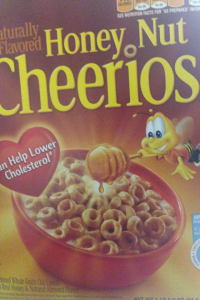
My image is from a Honey Nut Cheerios cereal box. The animal on the box is a cartoon honey bee and he is spreading honey on top of cereal in a bowl. This image of the bee is certainly unrealistic because real bees look nothing like this. This bee is very anthropomorphized because it has a smile, hands and a large head and is even wearing clothing. This image does not show this animal in its natural habitat and a bee would never actually be able to perform actions like it is shown doing on this box. Also, this bee is depicted as an extremely happy animal that enjoys spreading honey on cereal.
I think one of the common assumptions about food animals is that food animals are raised naturally and produce products in a way that is similar to the way that they produce products in nature, away from human contact. However, as discussed in Eating Animals by Jonathan Safran Foer, this assumption is completely incorrect. In this book, Foer discusses the many modifications that are implemented in order to keep animals as productive as possible. Although I am unsure of the changes that are established in the lives of bees to create a larger amount of honey production, after reading Foer’s book, I am curious about the steps that are taken to create maximum efficiency. One example of this that I am aware of is that bees that are used to produce honey for profit are often raised in boxes rather than traditional hives. This is similar to Foer’s discussion about factory farms where animals are raised in environments that are very different than the environment that they are meant to live in.
Although many people may think of family farms or wild bees when they think of these products, Foer mentions in his book that 99% of meat now comes from factory farms. It is likely that a large amount of honey production is also produced in similar factory-like settings. It is possible that many people are unaware of the extent of factory farming because of advertising that shows animals in unusually good states. This type of advertising can be described by one of the words that Foer discusses in the “Words/Meaning” chapter: “bullshit”. He defines this word as “Misleading or false language and statement.” Although this particular image does not use any false language, it portrays a false message. I believe that Foer would say that this image and other food advertisements similar to it are used to help the consumer think about positive, happy images of the animals so that they focus less on the reality of the situation such as factory farming and harsh treatment of animals.
As in many images that we have discussed in class, this image also provides an example of Berger’s discussion of the reduction of animals for the benefit of humans. The animal is reduced by humans because this animal’s life is probably extremely unnatural and the animal is used purely for its ability to make a product that humans want. In this case, the bee is used for its honey without any concern for the bee as an individual. Despite this poor treatment by humans, a falsified image of a happy bee is used for advertising as another way for humans to benefit from this animal. This makes it seem as if humans will use animals in any way as long as they can gain something.
Sources:
Berger, John. “Why Look at Animals?” About Looking. New York: Pantheon, 1980. 3-28. Print.
Foer, Jonathan Safran. Eating Animals. New York: Little, Brown, 2009. Print.
I really enjoyed how you used a non dairy or meat animal for this. Bees tend to get overlooked since they’re considered insect and not worthy of moral consideration, despite the fact that our consumerism is harmful to their species and habitat.
This reminds me of a famous quote from Albert Einstein: “If the bee disappeared off the surface of the globe, then man would have only four years of life left. No more bees, no more pollination, no more plants, no more animals, no more man.”
I guess that means we should respect bees more!!